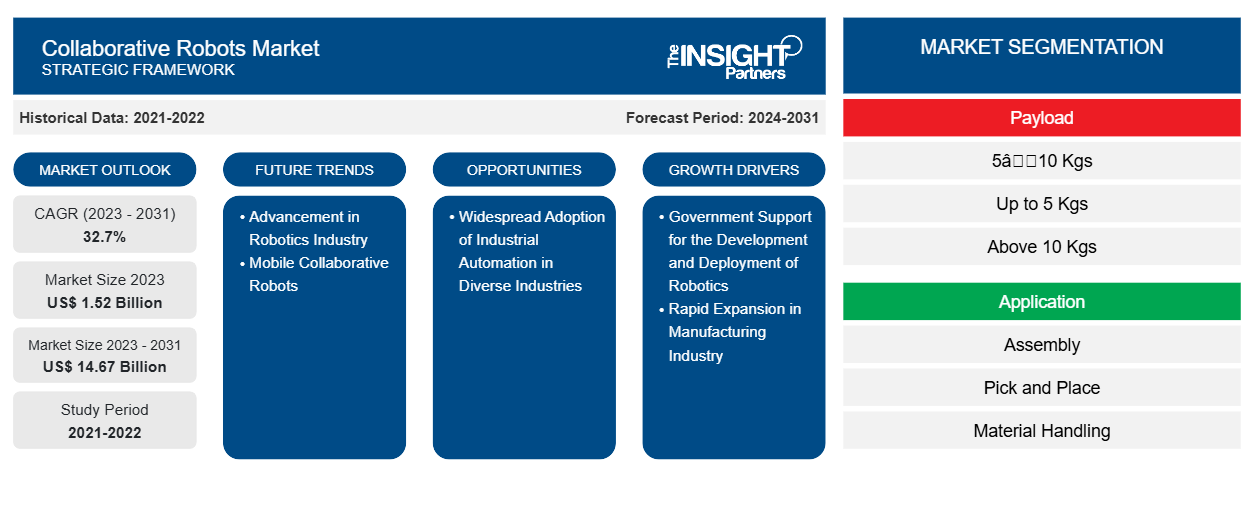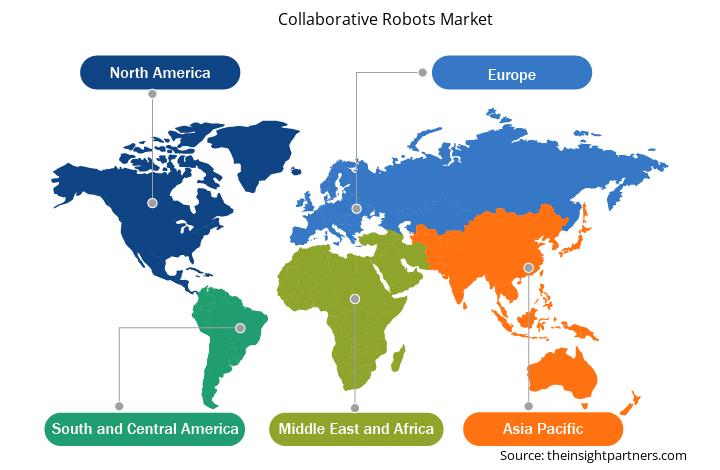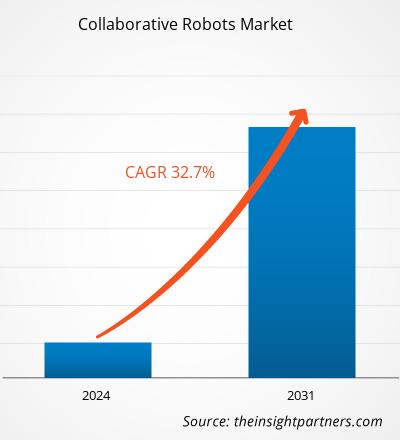협동 로봇 시장 규모는 2024년 18억 8천만 달러에서 2031년 146억 7천만 달러로 성장할 것으로 예상됩니다. 2025년부터 2031년까지 연평균 성장률(CAGR)은 35.7%에 이를 것으로 예상됩니다. 모바일 협동 로봇은 시장에 새로운 트렌드를 가져올 것으로 예상됩니다.
협동 로봇 시장 분석
협동 로봇은 자재 취급, 제조, 실험실 등에서 사용되는 서비스 로봇 분야입니다. 공장, 특히 인간과 로봇이 이미 조화롭게 협력하기 시작한 제조업 분야의 수요 증가는 협동 로봇 시장 성장을 견인하고 있습니다. 협동 로봇의 등장은 인간이 로봇과 안전하게 함께 작업할 수 있는 신뢰할 수 있는 작업 환경을 구축했습니다. 이 시장을 이끄는 주요 요인으로는 로봇 개발 및 도입에 대한 정부의 지원과 제조업의 급속한 성장이 있습니다.
협동 로봇 시장 개요
산업 환경은 협업 로봇의 등장으로 큰 변화를 겪고 있습니다. 첨단 기계는 인간과 함께 안전하고 효과적으로 작업하도록 설계되었습니다. 이러한 로봇은 안전성을 높이고 생산성을 높이며 지속 가능한 운영을 지원하는 지능형 팀원으로 진화하고 있습니다. 인간과 동등한 속도로 작동하는 협업 로봇은 동작 관련 위험 평가를 간소화하여 주변 작업자가 의도치 않은 접촉을 더 쉽게 피할 수 있도록 합니다.
전 세계 여러 국가 정부가 자국 내 로봇 개발 및 도입을 지원하고 장려하기 위한 이니셔티브를 추진하고 있습니다. 이러한 이니셔티브와 정부의 조치는 전 세계 산업용 로봇 시장 성장을 촉진하여 협동 로봇에 대한 수요를 증가시킬 것으로 예상됩니다. 2022년 유럽은 세계 협동 로봇 시장에서 가장 큰 매출 점유율을 기록했습니다. 유럽에서는 탄탄한 자동차 산업과 주요 프리미엄 자동차 제조업체들의 입지가 협동 로봇 시장을 견인할 것으로 예상됩니다. 또한, 전기차 제조 산업의 성장은 협동 로봇 시장 성장을 견인할 것으로 예상됩니다.
이 보고서의 일부 또는 국가 수준 분석, Excel 데이터 팩을 포함하여 모든 보고서에 대한 사용자 정의를 무료로 받을 수 있으며, 신생 기업 및 대학을 위한 훌륭한 혜택과 할인도 이용할 수 있습니다.
협동 로봇 시장: 전략적 통찰력

-
이 보고서에서 주요 시장 동향을 알아보세요.이 무료 샘플에는 시장 동향부터 추정치 및 예측까지 다양한 데이터 분석이 포함됩니다.
협동 로봇 시장 성장 동력과 기회
로봇 개발 및 보급을 위한 정부 지원
전 세계 여러 국가 정부가 자국 내 로봇 개발 및 도입을 지원하고 촉진하기 위한 이니셔티브를 추진하고 있습니다. 예를 들어 싱가포르 정부는 산업 변혁 프로그램(Industry Transformation Program)을 통해 기업의 혁신, 자동화, 확장을 촉진하고 자금을 조달하기 위한 여러 조치를 발표했습니다. 인도 정부는 생산 연계 인센티브(Production Linked Incentive, PLI) 제도를 포함하여 인도의 스마트 제조를 촉진하기 위한 다양한 조치를 취했습니다. 인도의 제조업을 촉진하기 위한 주요 정부 사업인 PLI 제도는 2020년에 시작되었으며 자동차, 제약, 섬유, 식품 가공, 백색 가전 등 14개 산업을 포괄합니다. 또한 중국 정부는 자국 제조업 부문에 산업용 로봇을 도입하기 위한 여러 조치를 취했습니다. 여기에는 첨단 산업 발전을 위한 "중국 제조 2025" 계획이 포함됩니다. 또한, 중국 정부는 산업용 로봇 부문 확대를 위한 5개년 "로봇 산업 발전 계획"을 발표했습니다. 정부는 산업 자동화에 상당한 보조금과 세금 감면을 제공하고 있습니다. 더욱이 독일의 인더스트리 4.0 이니셔티브에는 산업용 로봇의 개발 및 배치가 포함됩니다. 정부는 2016년부터 2020년까지 인간-기술 상호작용 연구를 위해 매년 약 7,800만 달러의 환불 불가 현금 보조금을 지원한다고 발표했습니다. 현재 정부는 자동화 및 로봇 공학 관련 약 300개의 연구 프로그램을 제공하고 있습니다.
한국 정부는 2014년부터 2018년까지 270만 달러 규모의 투자 계획인 제2차 지능형 로봇 발전 기본계획을 발표했습니다. 제2차 기본계획(2014년부터 2018년까지) 종료 후, 정부는 제3차 지능형 로봇 기본계획(2019년부터 2023년까지)을 수립하고 시행했습니다.
제조업의 급속한 확장
최근 산업 환경은 엄청나게 발전했으며, 협동 로봇은 중요한 변화를 주도하는 데 중요한 역할을 하고 있습니다. 기존 로봇과 달리 코봇은 인간과 함께 작업하도록 설계되었으며, 프로그래밍에는 일반적으로 인간의 협력을 필요로 하는 안전 조치가 포함되어 있어 독립적인 작동이 제한됩니다. 그럼에도 불구하고, 코봇은 상당한 생산성 향상을 제공하는 동시에 작업장 안전을 개선하고 더욱 유연하고 비용 효율적인 운영을 가능하게 합니다. 코봇은 현대 산업의 필수 요소로 자리 잡았으며, 제조업을 넘어 전 세계 물류 및 의료 시설까지 그 영향력을 확대하고 있습니다.
제조 분야에서 협동로봇은 조립, 용접, 기계 관리, 포장 또는 팔레타이징 작업에 널리 사용됩니다. 반복적이고 정밀한 작업을 수행할 수 있는 협동로봇은 제품 품질을 향상시키고 직원의 피로를 줄여줍니다. 협동로봇은 일상적인 작업을 자동화함으로써 작업자가 더 가치 있는 활동에 집중할 수 있도록 지원하여 궁극적으로 제조 운영 전반의 생산성, 효율성, 그리고 작업장 안전을 향상시킵니다. 전 세계 제조업은 빠르게 성장하고 있으며, 새로운 지역들이 제조 공장에 투자하고 있습니다. 이러한 성장은 공장 생산성 향상, 고객 우위 유지, 그리고 경쟁 우위 확보를 위한 기술 혁신을 촉진합니다. 따라서 제조업의 급속한 성장은 전 세계적으로 협동로봇에 대한 수요를 견인하고 있습니다.
협동 로봇 시장 보고서 세분화 분석
협동 로봇 시장 분석에 기여한 주요 부문은 탑재량, 응용 프로그램, 유형, 최종 사용자 산업 및 기능입니다.
- 시장은 탑재량을 기준으로 5~10kg, 5kg 이하, 10kg 이상으로 구분됩니다. 5~10kg 부문은 2024년에 가장 큰 시장 점유율을 기록했습니다.
- 시장은 응용 분야별로 조립, 픽앤플레이스, 자재 취급, 품질 테스트, 기계 관리, 용접, 포장 등으로 분류됩니다. 조립 부문은 2024년에 가장 큰 시장 점유율을 기록했습니다.
- 시장은 유형별로 로봇 팔, 용접 건, 그리퍼 등으로 구분됩니다. 로봇 팔 부문은 2024년에 가장 큰 시장 점유율을 기록했습니다.
- 최종 사용자 산업별로 시장은 자동차, 전자, 금속 및 기계, 식음료, 물류, 제약 등으로 세분화됩니다. 2024년에는 자동차 부문이 시장을 주도했습니다.
- 기능은 고정형 로봇과 이동형 로봇으로 구분됩니다. 2024년에는 고정형 로봇 부문이 시장을 주도했습니다.
지역별 협동 로봇 시장 점유율 분석
협동 로봇 시장 보고서의 지리적 범위는 주로 북미, 아시아 태평양, 유럽, 중동 및 아프리카, 남미 및 중미의 5개 지역으로 나뉩니다.
아시아 태평양 지역은 2024년에 상당한 협동 로봇 시장 점유율을 기록했습니다. 아시아 태평양 지역은 제조업 부문에서 상당한 성장을 보이는 여러 개발도상국으로 구성되어 있습니다. 이 지역은 다양한 제조업이 자리 잡은 세계적인 제조 허브로 성장했습니다. 중국이 고숙련 제조업의 중심지로 전환하는 동안, 인도, 한국, 대만, 베트남과 같은 신흥 경제국들은 저숙련 및 중숙련 제조업 운영을 이전하려는 기업들을 점점 더 유치하고 있습니다. 이들 국가는 경쟁력 있는 인건비를 제공하며, 정부의 적극적인 지원 정책을 통해 외국인 직접 투자를 적극적으로 장려하고 있습니다. 그러나 아시아 태평양 지역의 주요 제조 중심지로서의 입지를 굳건히 하기 위해서는 숙련 노동력 부족, 낮은 생산성, 미개발 인프라와 같은 과제를 해결해야 합니다.
아시아 태평양 개발도상국 정부는 제조업체들이 해당 국가에 공장을 설립하도록 유치하기 위해 세금 환급, 기금, 보조금 등 다양한 지원을 제공하고 있습니다. 또한, 여러 정부가 '중국 제조 2025'와 '인도 제조'와 같은 정책을 시행하고 있습니다. 그러나 최대 제조 허브인 중국은 인구 고령화로 인해 인건비가 상승하고 있습니다. 이로 인해 제조업체들은 동남아시아 국가에 투자를 모색하고 있습니다. 인프라 개선, 국내 소비 증가, 그리고 낮은 인건비는 제조업체들이 동남아시아 국가로 유치되는 몇 가지 요인입니다.
중국은 세계 최대 승용차 생산국입니다. 일본, 인도, 한국은 아시아 태평양 지역의 주요 자동차 생산국 중 일부입니다. 자동차 산업 외에도 중국의 여러 산업 분야에서 협동 로봇이 도입되고 있습니다. 예를 들어, 중국 최대 욕실용품 제조업체 중 하나인 샤먼 러너 산업 주식회사(Xiamen Runner Industrial Corporation)에서는 유니버설 로봇(Universal Robots)의 로봇 64대가 생산 라인에 투입되어 텐딩, 사출 성형기, 제품 조립 등 다양한 작업을 수행했습니다.
협동 로봇 시장 지역별 통찰력
Insight Partners의 분석가들은 예측 기간 동안 협동 로봇 시장에 영향을 미치는 지역별 동향과 요인을 면밀히 분석했습니다. 이 섹션에서는 북미, 유럽, 아시아 태평양, 중동 및 아프리카, 그리고 중남미 지역의 협동 로봇 시장 부문과 지역별 현황도 살펴봅니다.

- 협동 로봇 시장에 대한 지역별 데이터를 얻으세요
협동 로봇 시장 보고서 범위
| 보고서 속성 | 세부 |
|---|---|
| 2025년 시장 규모 | 18억 8천만 달러 |
| 2031년까지 시장 규모 | 146억 7천만 달러 |
| 글로벌 CAGR(2025~2031년) | 35.7% |
| 역사적 데이터 | 2021-2023 |
| 예측 기간 | 2025-2031 |
| 다루는 세그먼트 |
탑재량별
|
| 포함된 지역 및 국가 |
북아메리카
|
| 시장 선도 기업 및 주요 회사 프로필 |
|
협동 로봇 시장 참여자 밀도: 비즈니스 역학에 미치는 영향 이해
협동 로봇 시장은 소비자 선호도 변화, 기술 발전, 그리고 제품의 이점에 대한 인식 제고 등의 요인으로 인한 최종 사용자 수요 증가에 힘입어 빠르게 성장하고 있습니다. 수요가 증가함에 따라 기업들은 제품 및 서비스 확장, 소비자 니즈 충족을 위한 혁신, 그리고 새로운 트렌드를 적극 활용하고 있으며, 이는 시장 성장을 더욱 가속화하고 있습니다.
시장 참여자 밀도는 특정 시장이나 산업 내에서 활동하는 기업들의 분포를 나타냅니다. 이는 특정 시장 공간에 얼마나 많은 경쟁자(시장 참여자)가 존재하는지를 규모나 전체 시장 가치 대비로 나타냅니다.
협동 로봇 시장에서 운영되는 주요 회사는 다음과 같습니다.
- 쿠카 AG
- 야스카와 아메리카 주식회사
- 오보(베이징) 로보틱스 테크놀로지 유한회사
- 두산로보틱스 주식회사
- 파누크 주식회사
- ABB 유한회사
면책 조항 : 위에 나열된 회사는 특정 순서에 따라 순위가 매겨지지 않았습니다.

- 협동 로봇 시장의 주요 기업 개요를 알아보세요
협동 로봇 시장 뉴스 및 최근 동향
협동 로봇 시장은 1차 및 2차 조사 이후 주요 기업 간행물, 협회 데이터, 데이터베이스 등 정성적 및 정량적 데이터를 수집하여 평가합니다. 협동 로봇 시장의 몇 가지 동향은 다음과 같습니다.
- OMRON은 다양한 산업 분야의 다양한 용도에 맞춰 설계된 OMRON TM S 시리즈 협동 로봇을 출시했습니다. 이 협동 로봇은 첨단 하드웨어, 더욱 강화된 안전 기능 및 인증, 그리고 차세대 구성 기능을 탑재하여 이전보다 훨씬 사용하기 편리해졌습니다. (출처: OMRON, 보도자료, 2024년 9월)
- 국제적인 권위를 자랑하는 독립적인 제3자 시험, 검사 및 인증 기관인 TÜV 라인란드 그룹(TÜV Rheinland Group)은 ESTUN Automation Co., Ltd.에 ESS(ESTUN Safety Solution) 제품에 대한 CE 기계류 지침 및 기능 안전 적합성 인증서를 발급했습니다. 이는 ESTUN이 포괄적인 로봇 기능 안전 제품 시스템 구축에 있어 빠른 진전을 이뤘음을 의미합니다. 이 인증은 로봇 기술 분야에서 ESTUN의 혁신적인 역량과 전문성을 입증할 뿐만 아니라, 제품 안전 및 품질에 대한 엄격한 관리와 헌신을 반영하며, 글로벌 시장에서 ESTUN의 서비스 품질과 효율성을 더욱 향상시킬 것입니다. (출처: ESTUN Robotics, 보도자료, 2024년 4월)
협동 로봇 시장 보고서 범위 및 성과물
"협업 로봇 시장 규모 및 예측(2021~2031)" 보고서는 아래 영역을 포괄하여 시장에 대한 자세한 분석을 제공합니다.
- 범위에 포함된 모든 주요 시장 부문에 대한 글로벌, 지역 및 국가 수준의 협동 로봇 시장 규모 및 예측
- 협동 로봇 시장 동향 및 운전자, 제지 장치, 주요 기회와 같은 시장 역학
- 자세한 PEST 및 SWOT 분석
- 주요 시장 동향, 글로벌 및 지역 프레임워크, 주요 참여자, 규정 및 최근 시장 개발 사항을 포괄하는 협동 로봇 시장 분석
- 시장 집중도, 히트맵 분석, 주요 업체 및 협업 로봇 시장의 최근 개발 사항을 다루는 산업 환경 및 경쟁 분석
- 자세한 회사 프로필
- 과거 분석(2년), 기준 연도, CAGR을 포함한 예측(7년)
- PEST 및 SWOT 분석
- 시장 규모 가치/거래량 - 글로벌, 지역, 국가
- 산업 및 경쟁 환경
- Excel 데이터세트
최근 보고서
사용 후기
구매 이유
- 정보에 기반한 의사 결정
- 시장 역학 이해
- 경쟁 분석
- 고객 인사이트
- 시장 예측
- 위험 완화
- 전략 기획
- 투자 타당성 분석
- 신흥 시장 파악
- 마케팅 전략 강화
- 운영 효율성 향상
- 규제 동향에 발맞춰 대응






















 무료 샘플 받기 - 협동 로봇 시장
무료 샘플 받기 - 협동 로봇 시장